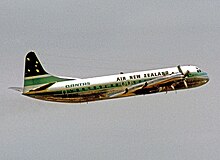Lockheed L-188 Electra
With its fairly high power-to-weight ratio, huge propellers and very short wings (resulting in the majority of the wingspan being enveloped in propwash), large Fowler flaps which significantly increased effective wing area when extended, and four-engined design, the airplane had airfield performance capabilities unmatched by many jet transport aircraft even today—particularly on short runways and high altitude airfields.[citation needed] Initial sales were good, but after two fatal crashes that led to expensive modifications to fix a design defect, no more were ordered.[4] The CL-310 design met the American Airlines requirements, but failed to meet those of another interested carrier, Eastern Air Lines.Its requirements were for a longer range, a minimum cruising speed of 350 miles per hour (560 km/h), and increased seating capacity to the 85-to-90-passenger level.[8][9] The changes were incorporated on the production line by mid-1959 or as modification kits for the aircraft already built, and resulted in improved performance and a better ride for passengers.The mounting of the gearbox cracked, and the reduced rigidity enabled a phenomenon called "whirl mode flutter" (analogous to the precession of a child's Spinning Top as it slows down, an interaction of propellers with airflow) that affected the outboard engine nacelles.In the South Pacific, Tasman Empire Airways Limited (TEAL) and its successor Air New Zealand flew the Electra on trans-Tasman flights.Most notably, Brazilian flag carrier airline Varig operated flawlessly a fleet of 14 Electras on the extremely busy Rio de Janeiro-São Paulo shuttle service (the so-called Ponte Aérea – or "Air Bridge" in Portuguese) for 30 years, completing over half a million flights on the route before the type was replaced by Boeing 737-300 and Fokker 100 jets in 1992.[19] The Electra became so iconic on that route that its retirement caused a commotion in Brazil, with extensive press coverage and many special tributes.Others were retired from passenger service into air-cargo use, 40 being modified by a subsidiary of Lockheed from 1968 with one or two large doors in the left side of the fuselage and a reinforced cabin floor.In 1983, after the retirement of its last SP-2H Neptune, the Argentine Navy bought further civilian Electra airframes, modified several for maritime patrol,[23] and widely used them until their replacement by P-3s in 1994.




Lockheed Model 10 ElectraTurbopropairlinerManufacturerLockheed CorporationAir SprayBuffalo AirwaysConair GroupEastern Air LinesAmerican AirlinesNational AirlinesLockheed P-3 OrionLockheedpower-to-weight ratiopropwashFowler flapsturbopropspiston-enginedConstellation seriesairframeLockheed L-1249 Super ConstellationCapital AirlinesVickers ViscountsRolls-Royce DartsNapier ElandsAllison 501-D13Lockheed C-130 Herculestype certificateCivil Aeronautics AdministrationManchester AirportAtlantic AirlinesVancouver AirportLas Mercedes AirportManagua, NicaraguaUnited States Navymaritime patrol aircraftmonoplanetricycle landing gearconventional tailmaximum take-off weightBraniff AirwaysNorthwest Airlinesengine nacellesresonantAir New ZealandQantasTasman Empire Airways LimitedTrans Australia AirlinesAnsettPort MoresbyNew CaledoniaNew GuineaLloyd Aéreo BolivianoLíneas Aéreas ParaguayasRio de JaneiroSão PauloBoeing 737-300Fokker 100Air CaliforniaPacific Southwest AirlinesLake Tahoe AirportSierra NevadaArgentine NavyDirty WarRio de La Platadeath flightsSP-2H Neptunemaritime patrolBahía BlancaYP-3A Orionaerial firefightingAnsett AirlinesAmerer AirNorthwest Territorial AirwaysNordairCanadian AirlinesTransport CanadaSAM ColombiaAerocondor ColombiaAerocostaTrans Service AirliftEcuatoriana de AviaciónTransportes Aereos Nacionales EcuatorianosTACA International AirlinesGuyana AirwaysCathay Pacific AirwaysGaruda Indonesia AirlinesMandala AirlinesHunting Cargo AirlinesRoyal Air LaoBanco de MéxicoMartinairAir ALMFred. Olsen AirtransportNordic AirCopa AirlinesLíneas Aéreas Nacionales SAAir Manila InternationalFalcon AirWest Air SwedenAir Bridge CarriersChannel ExpressAir FloridaAmerican Flyers AirlineBraniff International AirwaysDenver Ports of CallEvergreen International AirlinesFederal Aviation AdministrationGulf Air TransportHoliday AirlinesIntermountain AirlinesJohnson International AirlinesMcCulloch International AirlinesNational Center for Atmospheric ResearchOverseas National AirwaysReeve Aleutian AirwaysSaturn AirwaysSoutheast AirlinesTrans International AirlinesTransamerica AirlinesTrans International Airlines (1985–1989)Universal Airlines (United States)Western AirlinesZantop International AirlinesKaribu AirwaysArgentine Naval Aviation